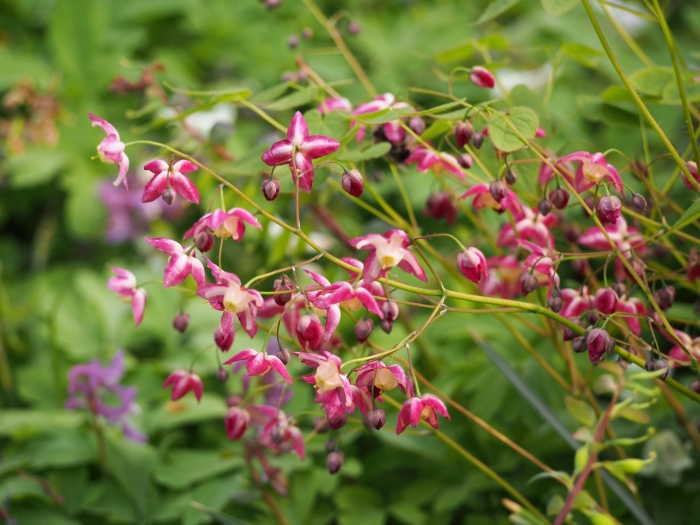Red Barrenwort
(Epimedium ×rubrum)
Red Barrenwort (Epimedium ×rubrum)
/
/

Agnieszka Kwiecień, Nova
CC BY-SA 4.0
Image By:
Agnieszka Kwiecień, Nova
Recorded By:
Copyright:
CC BY-SA 4.0
Copyright Notice:
Photo by: Agnieszka Kwiecień, Nova | License Type: CC BY-SA 4.0 | License URL: https://creativecommons.org/licenses/by-sa/4.0 | Uploader: Nova | Publisher: Wikimedia Commons | Title: Epimedium_x_rubrum_Epimedium_czerwone_2018-04-15_02.jpg | Notes: |


















Estimated Native Range
Summary
Epimedium ×rubrum, commonly known as Red Barrenwort, is a deciduous perennial herb that spreads by rhizomes, originating from an artificial cross between E. alpinum and E. grandiflorum. Red Barrenwort typically grows to about 30 cm (1.0 ft) tall and is known for its attractive foliage and flowers. The young leaves emerge in spring with a red tinge and transition to green; in autumn, they turn red again. The flowers, which are quite showy, appear alongside the young leaves in spring and are borne on a loose raceme. Each flower is about 2 cm (0.8 in) across, featuring red sepals and yellow petals, creating a striking contrast.
Red Barrenwort is valued for its ground-covering ability and its ornamental foliage and flowers. It is often used in shaded garden areas, woodland gardens, and for underplanting in shaded borders. It is recommended for cultivation in shade or part-shade and prefers moist, well-drained soil, but once established, it can tolerate drier conditions. To encourage fresh growth and optimal flowering, old foliage should be cut back before the new leaves and flowers emerge in spring. It is very hardy, withstanding temperatures below −20 °C (−4 °F), and was awarded the Royal Horticultural Society’s Award of Garden Merit in 1993. While generally pest-free, it can occasionally suffer from vine weevil or foliar nematodes.CC BY-SA 4.0
Red Barrenwort is valued for its ground-covering ability and its ornamental foliage and flowers. It is often used in shaded garden areas, woodland gardens, and for underplanting in shaded borders. It is recommended for cultivation in shade or part-shade and prefers moist, well-drained soil, but once established, it can tolerate drier conditions. To encourage fresh growth and optimal flowering, old foliage should be cut back before the new leaves and flowers emerge in spring. It is very hardy, withstanding temperatures below −20 °C (−4 °F), and was awarded the Royal Horticultural Society’s Award of Garden Merit in 1993. While generally pest-free, it can occasionally suffer from vine weevil or foliar nematodes.CC BY-SA 4.0
Plant Description
- Plant Type: Herb
- Height: 0.5-0.8 feet
- Width: 1-1.5 feet
- Growth Rate: Moderate
- Flower Color: Pink, White
- Flowering Season: Spring
- Leaf Retention: Evergreen
Growth Requirements
- Sun: Part Shade, Full Shade
- Water: Medium
- Drainage: Medium
Common Uses
Bank Stabilization, Bee Garden, Border Plant, Deer Resistant, Drought Tolerant, Erosion Control, Groundcover, Low Maintenance, Rabbit Resistant, Rock Garden, Street Planting
Natural Habitat
Epimedium × rubrum is a garden hybrid, valued for its ornamental foliage and flowers, used in shaded garden areas, and is very hardy
Other Names
Common Names: Bishop’s Hat
Scientific Names: Epimedium ×rubrum , Epimedium alpinum var. rubrum , Epimedium ×youngianum f. rubrum , Epimedium alpinum × grandiflorum , Epimedium alpinum f. rubrum , Epimedium alpinum x grandiflorum , Epimedium xrubrum
GBIF Accepted Name: Epimedium ×rubrum C.Morren